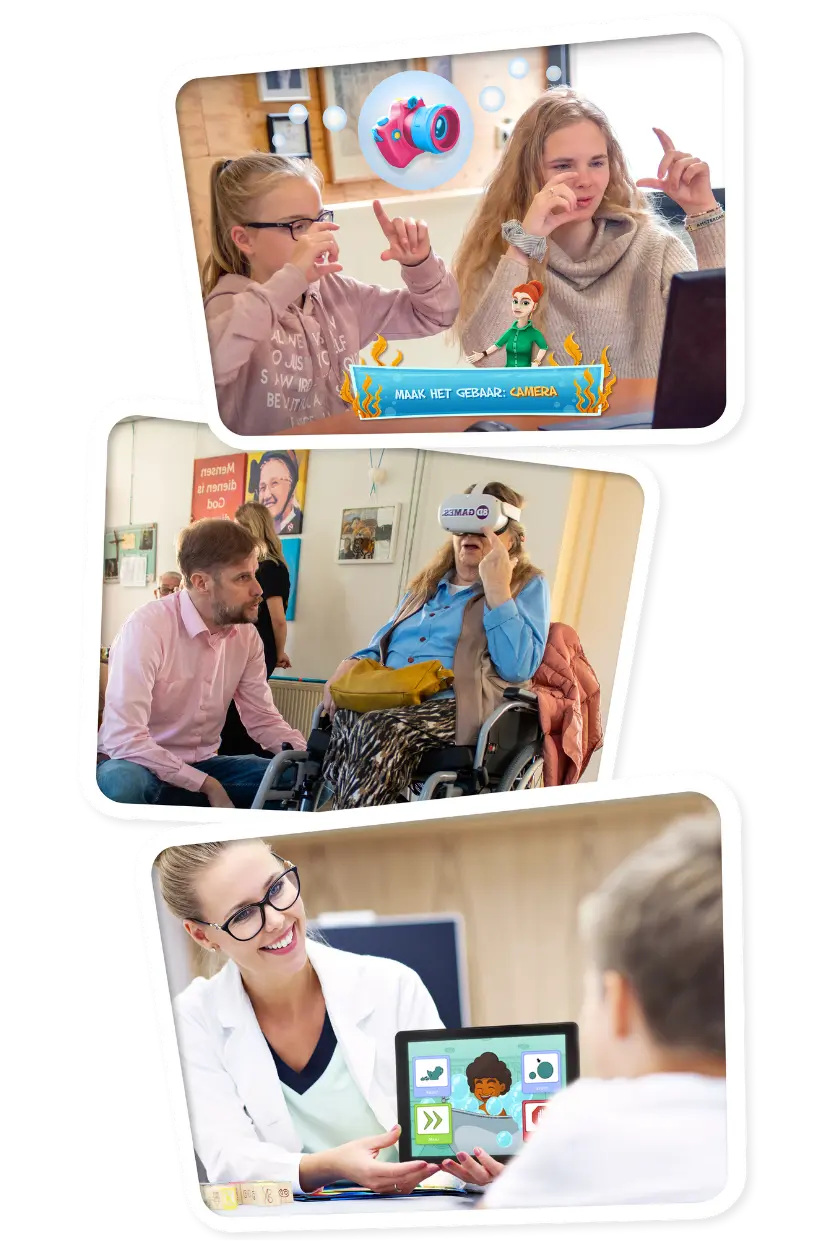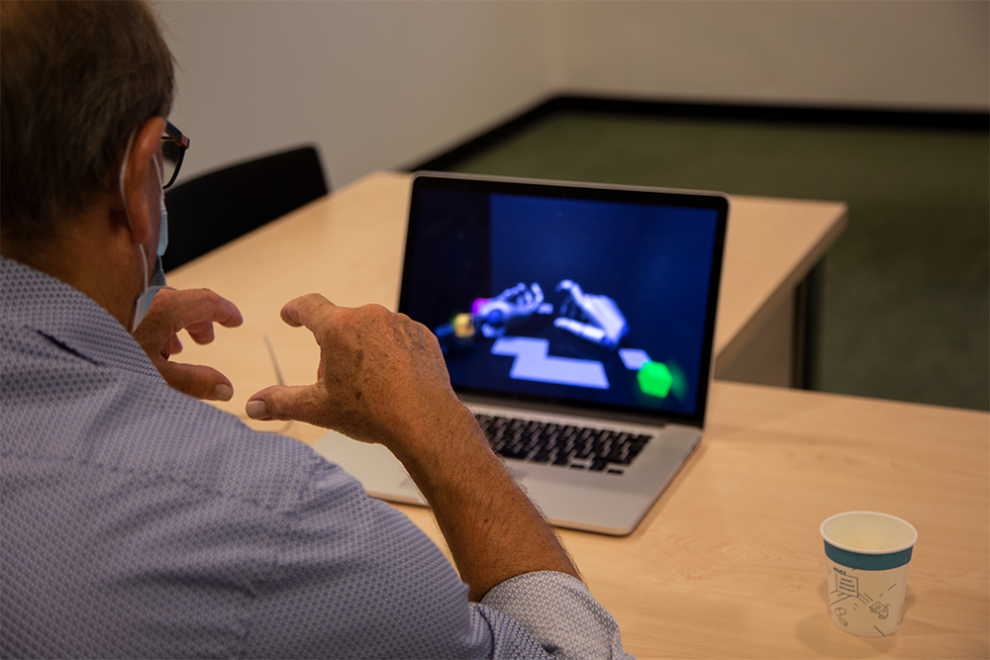Examples of serious gaming in healthcare
If you work in healthcare, you will probably have come across the term “serious gaming” over the past few years. I can well imagine that you do not immediately have…
Read blog
Serious games for healthcare are making their rise. But if you have never used such a game yourself, the whole idea remains somewhat abstract. What added value do games have for healthcare and what concrete examples are there? Get inspired by cases from our portfolio.
Navigation:

A serious game is a game with a purpose. For example, to convey information or increase therapy compliance in rehabilitation. Applying game principles helps achieve these goals. This is also true in healthcare, where there are currently many challenges for both patients and professionals.
What should you imagine in this context? For example, you might think of a game that motivates patients to keep doing their physical therapy exercises at home. Playing a game is easier to keep up than performing “just boring exercises. Such a game also offers many new possibilities for the practitioner.

Maarten likes to think along!
Why is serious gaming so valuable especially for healthcare? That has to do – besides the fun and effectiveness – with all kinds of practical and organizational advantages. Serious games for healthcare are, for example:
Healthcare costs have been rising for years and healthcare needs to be better and cheaper at the same time. Serious games can be a solution to this. An example: instead of receiving ten treatments from a physical therapist, it is possible to do part of the exercises at home with a game that gives the therapist direct insight into your progress. Based on the data from the game, the treatment can be tailored entirely to your needs. This saves a lot of time and money. An example from our own portfolio with such a measurement system is The Skating Game.


This brings us directly to the second advantage: care must be evidence-based . Games can provide very clear statistics. How often has the game been played and what deviation does the left have compared to the right? Where before you could picture your fidelity to the exercises a little nicer than had actually been the case, now your practitioner can say to you, ‘Well, in the EHR I see that you have done the exercises zero times…’ Of course, a good serious game ensures that this situation does not occur. After all, it is fun to play and designed to maintain the motivation to do the exercise.
To stay with the example of physical therapy exercises for a moment: research shows that after their appointment with the physical therapist, a proportion of people do not remember how to do the exercises they have learned at home. They then fail to do the exercise correctly or even suffer injuries due to incorrect posture. In a game, you can repeat the explanation again and again and even rule out people doing the exercise incorrectly, as with the Skating game. In short: serious gaming ensures that people can practice safely. This applies in all kinds of areas and sectors. Think, for example, of a game in which doctors in training can perform a trial operation or action as in our project VR training “Resuscitation of newborn babies.. If it goes wrong then no real person suffers; after all, it’s just a game.


Suppose you are a physician assistant and work in an emergency room. You then learn from the situations that present themselves. Maybe you see a broken leg thirty times, but have never practiced with pneumonia. You learn in real life, but that also makes you dependent on what comes in. In a game, you can specify exactly what you want to learn. Even better, you don’t have to wait an hour for your first patient, but can simply continue learning at your own pace. Serious games make learning easier and are adaptable to your learning needs. At home, on the train, at work. With a serious healthcare game, you can learn and game when it’s convenient, at your own level.
In conclusion, a good serious game designer ensures that the game works in a user-friendly and intuitive way, so no in-depth technical knowledge is needed. Moreover, they can often be played at home, together with family or friends. This has a connecting and threshold-reducing effect. For example: Learning sign language with a serious game (8D & Pento, 2019) or get started with Assisted Communication via any mobile device you have in your home (8D & Deelkracht, 2023). Interactive, personal, at home, together – all things that make it easier to learn new things, continue treatments and address issues together with your loved ones.

The healthcare industry has many facets therefore it is important to understand the different ways in which serious gaming can be applicable:
Definitely not! In recent years, we see that “serious” board games have also found their way into healthcare. Educational board games for healthcare professionals are great for encouraging professional development and improving communication between teams. They promote teamwork, strategic thinking and problem-solving skills. Moreover, playing a board game is a lot more sociable and relaxing than going through a mandatory course. A concrete example of a board game for healthcare is AI+Hospital, which we developed in 2023 in collaboration with DASH (Data Science Center in Health) of the University Medical Center Groningen.
So far, we have mostly discussed serious games for healthcare that focus on improving physical health. But mental well-being, of course, is just as important. And mental health care has also found its way to serious gaming. Fortunately, because especially for people with mental vulnerability, games can be a very valuable addition to treatment, for example as support in learning new habits and routines. Games invite consistent and repetitive practice of new behaviors. Just seeing your own progress visualized in a game can do wonders for the motivation to persevere. An example of a serious game for mental health is The Lifestyle Challenge. Our cooperation with GGz Centraal is still in full swing: in 2023, the prototype – which we made in co-creation with young people and practitioners – was delivered.
Encouraging people to exercise sufficiently is an essential part of preventive care. After all, regular exercise is a powerful means of preventing numerous health problems, including cardiovascular disease, diabetes, obesity and mental health problems. Healthcare providers can play a role in educating, motivating and guiding patients to embrace an active lifestyle – but it is often difficult to actually (and most importantly, long-term) change exercise behaviors in daily life. In recent years, many exercise interventions have been developed with a crucial component: gaming and gamification. What to imagine with that? Read the blog Gaming and exercise, a golden combo and for even more – heartwarming – inspiration check out our project Getting young and old moving with Virtual Reality.
One of our main focuses: we do not develop anything without the involvement of end users. Based on ten years of experience, we have developed our own social design method that ensures that stakeholders have a say at crucial moments. What distinguishes us from other social design parties is that we alternate this with pragmatism and momentum. In addition to moments of participation, we also help you make informed choices and keep the process efficient. Our goal is that after each step in our social design process there is a tangible result that can be built upon — even without our intervention.
Start at the end! Think carefully: for whom should this serious game for healthcare make a difference? And how am I going to reach these people, even after the research is complete? We often see serious games for healthcare get off to a promising start, but end up not reaching the end user. That’s a shame. And as a development party, together with partners and knowledge institutions, we would like to prevent healthcare innovations from ending up on the shelf.
That’s why we wrote a white paper on implementing healthcare innovations. Contrary to what people often think, implementation starts during the development process. Download the white paper, read it through, and feel free to contact us to talk through your plans. We like to get involved early in the innovation process.

Maarten likes to think along!
If you work in healthcare, you will probably have come across the term “serious gaming” over the past few years. I can well imagine that you do not immediately have…
Read blog